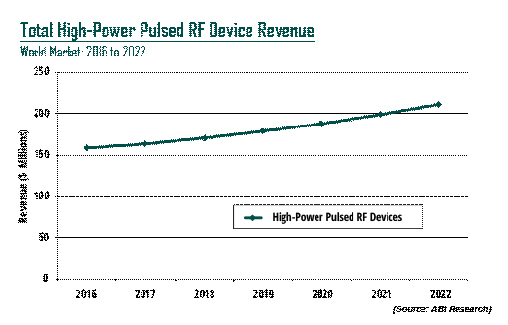ABI Research forecasts markets for pulsed RF power devices up to 4 GHz will show continued moderate growth over the next five years and exceed $200 million by 2022. While their association with consumer spending fuels the volatility of many global electronics markets, pulsed RF power device markets are supported by quite different priorities. Pulsed RF power transmitters generate tremendous amounts of power in small bursts that are useful for radar, airborne collision avoidance systems and military IFF equipment.
“Many RF power semiconductor manufacturers are on a quest to find markets unrelated to mobile wireless infrastructure,” says Lance Wilson, research director at ABI Research. “Device prices in wireless infrastructure are falling, and the total available market is flattening out.”
The airborne transportation safety market and military market are both experiencing solid growth in pulsed RF power device shipments. The markets use the devices for military radar, weather and marine applications, and in the current worldwide upgrade of the air traffic control system. The avionics transponder and air navigation market segment is also seeing growth, which is further lifted by the overall worldwide air traffic control upgrade. Intrinsically less “optional” than many consumer markets, these segments are therefore less sensitive to economic upheavals than consumer-driven markets, although they are not totally immune to the macro economy.
Understanding this, many semiconductor manufacturers are attempting to enter this market space; however, some factors may complicate their efforts. Pulsed RF power device markets are becoming very competitive technologically: GaN devices are vying for market share along with the more established Si and GaAs based technologies. With many companies rushing into these markets, ABI Research speculates that there may not be the market size to support them all.
“Undoubtedly, some consolidation will continue to occur beyond what already happened,” concludes Wilson. “While not guaranteed success, those companies that have track records working with government agencies and defense contractors will have an advantage over those that are new entrants.”
Leaders for high-power RF pulsed semiconductor devices include Ampleon, Integra Technologies, MACOM , Microsemi, Qorvo, Sumitomo Electric Device Innovations and Wolfspeed.

